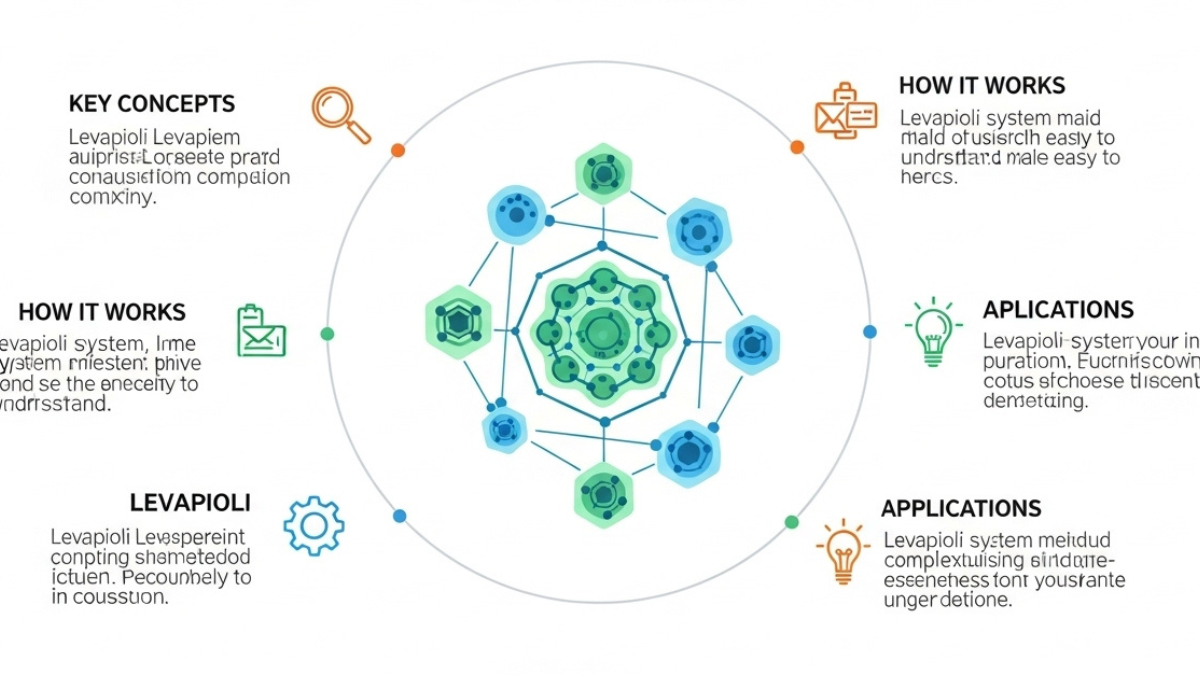topic
Understanding Levapioli: A Basic Guide

Origin and History
Levapioli, an intricate yet fascinating concept, has a rich history steeped in the exploration of its capabilities and impact across various domains. Though its origins remain somewhat obscure, its traces can be found in early 20th-century scholarly works focusing on interdisciplinary methodologies. Over the decades, Levapioli has evolved, reflecting the dynamic shifts in societal needs and technological advancements. Understanding its historical context provides a lens through which its contemporary applications can be better appreciated.
Definition and Core Concepts
At its core, Levapioli represents a theoretical framework that integrates multiple paradigms to address complex phenomena. It combines aspects of philosophy, systems theory, and applied sciences to offer a unique perspective on problem-solving. Key components of Levapioli involve modular thinking, adaptive strategies, and a systemic approach to interrelated challenges. These core concepts facilitate a deeper comprehension of interconnected systems ranging from ecological models to digital infrastructures.
Relevance in Modern Contexts
In today’s world, Levapioli holds considerable relevance due to its ability to offer comprehensive solutions to multifaceted problems. Its application in areas such as sustainable development, technological innovation, and strategic management underscores its utility. By fostering an understanding of both micro and macro elements within a system, Levapioli enables decision-makers to craft informed strategies that align with contemporary demands.
Key Characteristics of Levapioli
Unique Features
One of the distinct features of Levapioli lies in its holistic approach. Unlike traditional frameworks that often entail linear processes, Levapioli supports a non-linear, multi-dimensional perspective. This approach facilitates the examination of variables that might otherwise be overlooked. Furthermore, its adaptability allows it to be customized for a wide range of fields, making it highly versatile.
Fundamental Principles
At the heart of Levapioli are principles that emphasize the integration and synthesis of knowledge. It advocates for the breaking down of silos in knowledge creation, supporting an inclusive collaboration between diverse disciplines. This integrative approach not only enhances innovative capacity but also ensures more robust, resilient outcomes. By prioritizing adaptability and interconnectedness, Levapioli offers a profound way to view and engage with complex issues.
Applications and Benefits
Everyday Uses
Levapioli finds numerous applications in day-to-day life, particularly in areas requiring systemic thinking and cooperative approaches. In education, it informs teaching philosophies that promote interdisciplinary learning. In healthcare, Levapioli principles guide holistic patient care models that consider physical, mental, and social health. Its influence is similarly felt in organizational development, where cross-functional teams leverage Levapioli to achieve optimal results in dynamic environments.
Advantages Over Alternatives
Compared to other frameworks, Levapioli stands out for its adaptability and depth. While alternative methodologies may localize focus to specific aspects of a problem, Levapioli’s comprehensive consideration of various elements allows for a more nuanced and effective resolution. Its ability to anticipate potential challenges through broader analysis provides a strategic edge, notably in contexts where rapid adaptation is crucial.
Challenges and Considerations
Common Misunderstandings
Despite its benefits, Levapioli is not without its challenges. A typical misunderstanding is viewing it as a one-size-fits-all solution. On the contrary, effective application requires a nuanced understanding of its fundamental dynamics and the specific context of use. Misinterpretations of its principles can lead to oversimplifications or misapplications, potentially resulting in suboptimal outcomes.
Potential Limitations
There are also inherent limitations to Levapioli, primarily related to its complexity and the resource-intensive nature of its implementation. It demands a high level of expertise and a commitment to continual learning and adaptation, which can be significant barriers for some organizations or individuals. Additionally, real-world constraints such as limited resources and resistance to change can challenge its full potential. Nevertheless, by acknowledging these limitations, proponents of Levapioli can better strategize to overcome obstacles and harness its transformative power effectively.
topic
Mastering Seam Types: A Complete Guide to Nahttypen in Sewing and Garment Construction

INTRODUCTION TO NAHTTYPEN
In the world of sewing and garment construction, the concept of Nahttypen, which translates from German to “seam types”, holds essential importance. Seams are the backbone of any textile or clothing project, and understanding the various types — or nahttypen — is fundamental to creating garments that are not only durable but also visually appealing and functionally appropriate. Whether you are a seasoned tailor, a home hobbyist, or a professional in the textile industry, the knowledge of seam types empowers you to make smarter design decisions, prevent garment failures, and elevate the overall quality of your work.
Seam types affect everything from the aesthetic finish of the clothing to wearability, comfort, and fabric behavior. In an era of fast fashion and technical textiles, mastering nahttypen can set apart quality craftsmanship from substandard production. This guide explores nahttypen in a comprehensive format — their history, types, usage, and advanced methods — to equip you with both the foundational knowledge and nuanced expertise required for mastering seam work in modern sewing projects.
HISTORY AND ORIGIN OF NAHTTYPEN
The term Nahttypen originates from the German language, where “Naht” means seam and “Typen” translates to types. While seams have been a fundamental part of textile construction for thousands of years, the categorization of seam types as we know them today began with the industrial revolution and further matured with the rise of mass garment manufacturing in Europe, particularly in Germany. Before industrialization, most sewing was done by hand, and seam types were passed down through generations informally. However, with the invention of the sewing machine in the 19th century and the emergence of clothing as a mass-produced commodity, standardized seam classifications became necessary to streamline production and ensure consistency.
Germany and other European nations developed technical terminologies and sewing standards, and Nahttypen became a core part of training manuals, engineering specifications for textile machinery, and tailoring curriculums. Today, seam types are not only classified traditionally but also codified by international standards such as ISO 4916, which details technical seam constructions. The evolution of nahttypen has mirrored the progress of fashion and fabric technology, adapting to innovations in fabric properties, consumer demands, and sustainability practices.
DIFFERENT TYPES OF NAHTTYPEN WITH DETAILED EXPLANATION
Nahttypen can be broadly classified based on their construction and the function they serve. Some seams are purely structural, meant to hold fabric pieces together, while others are decorative or protective in nature. The Plain Seam (Einfache Naht or Steppnaht) is the most fundamental seam type, where two fabric edges are placed right sides together and sewn along the edge. It is used in shirts, dresses, and other lightweight garments. Another widely used seam is the French Seam (Französische Naht), which encloses the raw edges within the seam itself, offering a clean, refined interior — ideal for silk or transparent fabrics.
The Flat-Felled Seam (Kappnaht) is popular in jeans and workwear due to its incredible durability; it involves folding and topstitching one seam allowance over the other to enclose the raw edge. For stretch fabrics, the Zigzag Seam (Zickzacknaht) and Overlock Seam (Overlocknaht) are preferred. Overlock seams are performed using a serger machine and create a professional, fray-proof edge, while zigzag stitches allow flexibility and movement. Bound Seams (Einfassnaht), where raw edges are enclosed in binding tape, are used in unlined jackets or decorative finishes. Lapped Seams (Überlappte Naht), where one fabric layer is lapped over the other and stitched, are common in leather goods and upholstery. Each of these nahttypen serves a unique purpose, and mastery of their construction requires not only technical skill but an understanding of fabric behavior, garment design, and functional requirements.
COMMON MISTAKES TO AVOID WHEN WORKING WITH NAHTTYPEN
Despite their importance, many sewing enthusiasts and even professionals often overlook critical details when working with nahttypen. One of the most common mistakes is ignoring fabric compatibility — using a seam type that doesn’t align with the properties of the fabric can lead to puckering, breakage, or discomfort. For example, using a plain seam on stretch fabric can result in popped stitches, while using a bulky seam on delicate fabric can cause it to hang awkwardly.
Another frequent error is failing to finish the raw edges, especially in fabrics prone to fraying like linen or loosely woven cotton. If left unfinished, even the strongest seams can deteriorate over time. Improper seam allowance is another issue; different seams require different allowances, and miscalculations can lead to fitting problems or insufficient fabric for proper construction. Not pressing seams properly is also a major oversight. Pressing helps flatten the fabric, set the stitches, and give a crisp, professional finish. Beginners also often forget to test their seams on a scrap piece before sewing on the actual garment, missing a critical step that helps prevent costly errors. Avoiding these mistakes is not just about technical accuracy — it’s about elevating the entire sewing process into a craft of precision and excellence.
ADVANCED TECHNIQUES AND TIPS FOR PERFECT SEAMS
For those looking to elevate their sewing to professional or couture levels, mastering advanced techniques related to nahttypen is essential. One such technique is the Hong Kong finish, a variation of the bound seam using bias-cut fabric strips for a luxurious interior seam finish — perfect for unlined jackets and tailored garments. Flatlock seams, typically performed on a coverstitch machine, offer stretch and flatness ideal for activewear and undergarments, and can even be used decoratively with contrasting thread.
Another advanced skill is mastering seam manipulation — where you alter the seam structure to achieve a desired shape or silhouette. This includes converting darts into princess seams or rotating seams for better drape and movement. For waterproof garments, taping or sealing seams using heat or adhesive is a specialized technique that ensures water resistance. Using interfacing within seams can provide additional support and prevent distortion in areas like zippers, pockets, or buttonholes. Professional tailors also use understitching and stay stitching to keep seams flat and prevent fabric warping.
Learning how to use a walking foot or seam guide attachments can improve accuracy on slippery or thick fabrics. Finally, documenting your seam choices in a project notebook — noting stitch length, thread tension, and pressing techniques — builds a personalized seam library that aids consistency across future projects. These advanced methods require practice and attention to detail but can significantly elevate your craftsmanship.
CONCLUSION : THE IMPACT OF NAHTTYPEN ON SEWING PROJECTS
In the intricate art of sewing and garment creation, nahttypen are more than just construction techniques — they are the structural and aesthetic foundation upon which quality is built. A deep understanding of seam types can transform a project from ordinary to exceptional. The choice of seam influences not just the look of a garment but its comfort, functionality, and longevity.
They allow designers to tailor their creations to the needs of the end-user, whether that be comfort, style, mobility, or protection. In today’s dynamic world of textiles — with innovations in smart fabrics, sustainability, and wearable tech — seam types are evolving, but their core significance remains. As such, learning about, practicing, and perfecting different seam types is not just a technical pursuit, but an artistic one. It enhances the ability to tell stories through fabric, one seam at a time.
-

 FASHION3 weeks ago
FASHION3 weeks agoWhy Fashion Is Important to People: A Deep Dive Into Its Cultural, Psychological, and Social Impact
-

 BLOG1 month ago
BLOG1 month agoExploring the Revolutionary Potential of New Software 418DSG7
-

 NEWS1 day ago
NEWS1 day agoForestry Development Authority: Guardians of Our Forests
-

 HEALTH2 weeks ago
HEALTH2 weeks agoMega-Personal.net Health Archives: The Ultimate Guide to Health Information and Resources
-

 CRYPTO1 day ago
CRYPTO1 day agoCrypto30x.com: A Comprehensive Investigation Into the 30X Returns Crypto Platform
-

 CRYPTO7 days ago
CRYPTO7 days agoLessInvest.com Crypto: A Comprehensive Guide to Smart Cryptocurrency Investing
-

 CRYPTO15 hours ago
CRYPTO15 hours agoWhich Crypto Has 1000x Potential? A 2025 Investor’s Deep Dive into the Next Crypto Explosion
-

 NEWS1 day ago
NEWS1 day agoTecnoregio News: Your Ultimate Guide to Innovation, Industry Updates, and Regional Technology Insights
